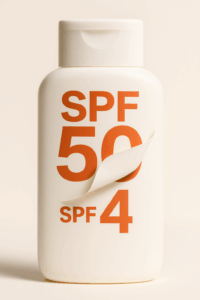
Australia’s status as the world’s skin‑cancer capital makes the recent revelations about sunscreen SPF failures all the more alarming. A major consumer investigation conducted in mid‑2025 revealed that many widely sold sunscreens were not providing the protection they claimed, shaking public confidence and prompting recalls, regulatory reviews, and widespread debate about sunscreen testing practices. While this story has played out most visibly in Australia, the problem extends far beyond its borders, raising concerns about sunscreen reliability across the globe.[1,2]
In June 2025, Choice Australia, a respected consumer‑advocacy group, tested 20 SPF 50 and SPF 50+ sunscreens in accredited laboratories. The results were shocking: 16 of the 20 products failed to deliver the protection they advertised.
Among the most troubling cases, Ultra Violette’s Lean Screen SPF 50+ tested at an SPF as low as 4, essentially offering almost no meaningful protection against sunburn despite its label. The discrepancy was so surprising that Choice commissioned a second test, which again confirmed the product’s failure. Other well‑known products from Neutrogena, Banana Boat, Bondi Sands, and even the Cancer Council also fell short of their advertised SPF claims.[1,2]
The news hit especially hard in Australia, where two‑thirds of the population will be diagnosed with skin cancer at some point in their lifetime, making sunscreen use not a cosmetic convenience but a matter of public‑health survival.
Beyond Australia – U.S. Market Findings
Independent laboratory studies in the United States have demonstrated that many American sunscreens underperform when it comes to UVA protection, with results showing a consistent gap between what is promised on the label and what is actually delivered, especially when compared to stricter European or Asian standards.[3,4]
The Environmental Working Group’s 2024 Sunscreen Guide further highlighted that many U.S. sunscreens allow far more UVA exposure than is ideal, pointing to a systemic problem in how products are tested and regulated.[5]
Personal Experience Developing a Sunscreen
Early on, I puzzled over how many sunscreens on the market could be so thin, liquid, and easy to apply, yet still claim high SPF values. It seemed almost counterintuitive, until I realized that such formulations often rely on additional chemical agents that (theoretically) boost SPF numbers, but which may or may not actually protect skin.
This presented me with a philosophical choice: should I chase a lotion‑like consistency that consumers might find convenient but which required more potentially harmful chemicals, or should I accept a thicker, creamier texture that was less cosmetically appealing but more aligned with my goals of safety and simplicity? Ultimately, I chose the latter, deliberately formulating a thicker cream with fewer questionable additives, and certainty about efficacy.
The second major challenge was the testing process itself. SPF testing is both costly and unforgiving. My first formulation did not pass. An expensive lesson that forced me to scrap the recipe and return to the drawing board. After several rounds of development, I eventually settled on an SPF 15 product. The decision was deliberate: pushing higher would have required either much higher concentrations of certain chemicals or resulted in an unpleasant, sticky texture that few would want to use daily. I decided that offering a safer, simpler, and more comfortable product mattered more than chasing a bigger number on a label, even if it meant being less competitive in a market where “SPF 50+” dominates the shelves.
How SPF Values Are Assigned
In most countries, including Australia, Europe, and the U.S., SPF is still determined through in vivo testing on human volunteers under controlled conditions (ISO 24444:2019).[6]
In vivo tests are done on real people’s skin under controlled sunlight exposure, while in vitro tests are performed in the lab on samples or artificial skin using instruments that measure how much UV light the product blocks.
The current in vivo method compares the amount of UV exposure needed to cause minimal sunburn (erythema) on protected versus unprotected skin. While the procedure is standardized, it is expensive, labor‑intensive, and subject to significant variability. Studies have shown that inter‑laboratory differences can result in as much as a 20–50 % swing in SPF results for the same product, particularly at higher SPF values.[7] You can read more about the details of SPF testing in an article we previously published.
Ethical concerns about deliberately inducing sunburn in volunteers, along with the expense and variability, have fueled calls to replace or supplement these methods with more reliable in vitro approaches using spectrophotometry and artificial skin substrates. ISO 24443:2021 (formerly 2022) describes an in vitro procedure for determining UVA‑photoprotection, critical wavelength, and UVA absorbance proportionality.[8] This standard is the basis for the EU’s requirement that a product’s UVA‑PF be at least one‑third of its labeled SPF (UVA/UVB ≥ 0.33) and for the EWG’s modeling of balanced protection.
Systemic Absorption Concerns
Two influential FDA‑led studies, published in JAMA in 2019 and 2020, demonstrated that several common UV filters, such as avobenzone, oxybenzone, octocrylene, and ecamsule, are absorbed through the skin into the bloodstream at levels exceeding thresholds that automatically trigger additional toxicology testing requirements by the FDA.[9,10]
These findings don’t mean sunscreens are unsafe, but they highlight the need for more data to fully understand long‑term implications. We’ve discussed this issue in detail in previous articles on Nature’s Complement, where we examined what systemic absorption might mean for everyday users [11] and why transparency on ingredients is essential.
Regulatory Lag in the United States
The FDA has been slow to approve newer UV filters that are already widely used in Europe and Asia, meaning American consumers often have access to fewer, and sometimes less effective, protection options. Experts argue that modernizing U.S. sunscreen regulations could both improve protection and expand consumer choice, aligning safety and efficacy standards with the latest global science.[12]
A Personal Solution
For readers who, like me, are wary of excessive chemical exposure but still want reliable sun protection, I eventually developed a product that reflected my own values. My Shield Sunscreen (SPF 15) represents a conscious compromise: lower SPF, yes, but formulated to avoid unnecessary additives, offering a safer and more comfortable product.[13,14]
The Australian sunscreen scandal has revealed what many scientists, dermatologists, and consumer advocates have long suspected: SPF numbers are not always what they seem. Whether it is inter‑lab variability, reliance on chemical boosters, or systemic‑absorption questions, the current state of sunscreen testing and regulation leaves much to be desired. Until better systems are in place, the best approach for consumers is to remain informed, pair sunscreen with hats, sunglasses, clothing, and shade, and not rely on any single product as a perfect shield against the sun. Sun protection is a strategy, not a number on a bottle.
References
- NDTV – “Australia Sunscreen Scandal and a Debate Over SPF Claims in Skin Cancer Hotspot.” June 2025.
- Caliber.az – “Safety of Sunscreen Products Under Scrutiny After Australia’s Scandalous Test Results.” June 2025.
- The Guardian – “As a heatwave approaches, experts say US sunscreens are less effective than those abroad.” 21 Jun 2025.
- Andrews DQ et al. – “Laboratory testing of sunscreens on the US market finds underperformance relative to SPF and UVA claims.” Photodermatol Photoimmunol Photomed 2022.
- Environmental Working Group (EWG) – “2024 Sunscreen Guide: UVA protection findings.” 2024.
- ISO 24444:2019 – “Cosmetics — Sun protection test methods — In vivo determination of the sun protection factor (SPF).”
- Cole C et al. – “The variability of in vivo sunscreen sun protection factor values between laboratories.” Photochem Photobiol Sci 2025.
- ISO 24443:2021 – “Cosmetics — Determination of sunscreen UVA photoprotection in vitro.”
- Matta MK et al. – “Effect of Sunscreen Application Under Maximal Use Conditions on Plasma Concentration of Sunscreen Active Ingredients.” JAMA 2019.
- Matta MK et al. – “Effect of Sunscreen Application on Plasma Concentration of Sunscreen Active Ingredients.” JAMA 2020.
- Nature’s Complement – “New JAMA study shows sunscreen chemicals are absorbed systemically.” 11 May 2019.
- Turner CW – “Modernizing U.S. Sunscreen Regulations: How Newer UV Filters Could Improve Public Health.” 2025.
- Nature’s Complement – “Shield Sunscreen (SPF 15) – Product page.” (primary source).
- Nature’s Complement – “Shield Sunscreen (SPF 15) – Product page.” (author‑generated, not independently verified).
Nature's Complement is a participant in the Amazon Services LLC Associates Program, an affiliate advertising program. If you purchase products on Amazon through any of our affiliate links, we get a small percentage of the transaction, at no extra cost to you. We spend a lot of time writing the articles on this site, and all this information is provided free of charge. When you use our affiliate links, you support the writing you enjoy without necessarily buying our products. (However we would appreciate if you would do that too!) Thank you for helping to support our work, however you choose to do so.
These statements have not been evaluated by the Food and Drug Administration. This information and/or products are not intended to diagnose, treat, cure or prevent any disease.


